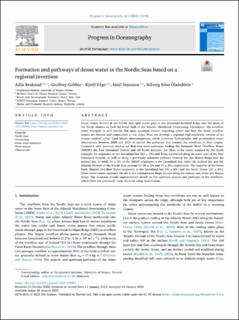| dc.contributor.author | Brakstad, Ailin Dale | |
| dc.contributor.author | Gebbie, Geoffrey | |
| dc.contributor.author | Våge, Kjetil | |
| dc.contributor.author | Jeansson, Emil | |
| dc.contributor.author | Olafsdóttir, Solveig R. | |
| dc.date.accessioned | 2023-06-29T08:23:56Z | |
| dc.date.available | 2023-06-29T08:23:56Z | |
| dc.date.created | 2023-03-17T13:17:22Z | |
| dc.date.issued | 2023 | |
| dc.identifier.issn | 0079-6611 | |
| dc.identifier.uri | https://hdl.handle.net/11250/3074288 | |
| dc.description.abstract | Dense waters formed in the Nordic Seas spill across gaps in the Greenland-Scotland Ridge into the abyss of the North Atlantic to feed the lower limb of the Atlantic Meridional Overturning Circulation. The overflow water transport is well known, but open questions remain regarding where and how the dense overflow waters are formed and transported to the ridge. Here we develop a regional high-resolution version of an inverse method called Total Matrix Intercomparison, which combines hydrographic and geochemical tracer observations between 2000 and 2019 to resolve the pathways that connect the overflows to their origins. Consistent with previous studies we find two main pathways feeding the Denmark Strait Overflow Water (DSOW): the East Greenland Current and the North Icelandic Jet. Most of the water supplied by the North Icelandic Jet originates in the Greenland Sea (82 ± 2%) and flows southward along an outer core of the East Greenland Current, as well as along a previously unknown pathway crossing the Jan Mayen Ridge into the Iceland Sea. In total, 39 ± 2% of the DSOW originates in the Greenland Sea, while the Iceland Sea and the Atlantic Domain of the Nordic Seas account for 20 ± 3% and 19 ± 2%, respectively. The majority of the Faroe Bank Channel Overflow Water originates in the Greenland Sea (46 ± 8%) and the Arctic Ocean (25 ± 9%). These dense waters approach the sill in the Iceland-Faroe Slope Jet and along the eastern side of the Jan Mayen Ridge. The inversion reveals unprecedented details on the upstream sources and pathways of the overflows, which have not previously been obtained using observations. | en_US |
| dc.language.iso | eng | en_US |
| dc.publisher | Elsevier | en_US |
| dc.rights | Navngivelse 4.0 Internasjonal | * |
| dc.rights.uri | http://creativecommons.org/licenses/by/4.0/deed.no | * |
| dc.title | Formation and pathways of dense water in the Nordic Seas based on a regional inversion | en_US |
| dc.type | Journal article | en_US |
| dc.type | Peer reviewed | en_US |
| dc.description.version | publishedVersion | en_US |
| dc.rights.holder | Copyright 2023 the authors | en_US |
| dc.source.articlenumber | 102981 | en_US |
| cristin.ispublished | true | |
| cristin.fulltext | original | |
| cristin.qualitycode | 1 | |
| dc.identifier.doi | 10.1016/j.pocean.2023.102981 | |
| dc.identifier.cristin | 2134797 | |
| dc.source.journal | Progress in Oceanography | en_US |
| dc.relation.project | Office of Naval Research - Global (ONR-Global): N62909-22-1-2023 | en_US |
| dc.relation.project | National Science Foundation: OCE-1850753 | en_US |
| dc.relation.project | Trond Mohn stiftelse: BFS2016REK01 | en_US |
| dc.relation.project | NASA National Aeronautics and Space Administration: 80NSSC20K0419 | en_US |
| dc.subject.nsi | VDP::Oseanografi: 452 | en_US |
| dc.subject.nsi | VDP::Oceanography: 452 | en_US |
| dc.identifier.citation | Progress in Oceanography. 2023, 212, 102981. | en_US |
| dc.source.volume | 212 | en_US |

